Nanomedical Devices
1/51
There's no tags or description
Looks like no tags are added yet.
Name | Mastery | Learn | Test | Matching | Spaced |
|---|
No study sessions yet.
52 Terms
Nanotechnology
Devices or materials of size in the range of 1-1000 nm
Nanomedicine
Applications of nanotechnology in healthcare
Multidisciplinary Area of Nanomedicine (8)
Requires input from medicine and science, including:
Medical physics
Biophysics
Biochemistry
Human biology
Engineering
Mathematics
Computer science
Promise of Nanomedicine
Potential to revolutionize medicine through:
New methods for disease prevention, diagnosis, and therapy
Rapid and easy Point-of-Care (POC) testing
Home health status screening
Personalized therapy tailored to individual patients (precision medicine)
Why therapies should be individualized?
Bc people bodies different thus they react differently - but in reality they treat people the same with different doses
Diameter of Human Hair
20,000 nm to 180,000 nm
Size of a Cell
Approximately 10,000 nm
Length of DNA in Human Chromosome #1
67,000 nm
Width of DNA Molecule
2.5 nm
Smallest Capillaries in the Body
Diameter ranges from 5,000 nm to 10,000 nm
Cellular Membrane K+ Channel Diameter
10 nm
Nuclear Membrane Channel Diameter
10 nm
Mitochondrial Membrane Channel Diameters
2 nm to 3 nm
Size of Nanodevices / Nanomaterials reference
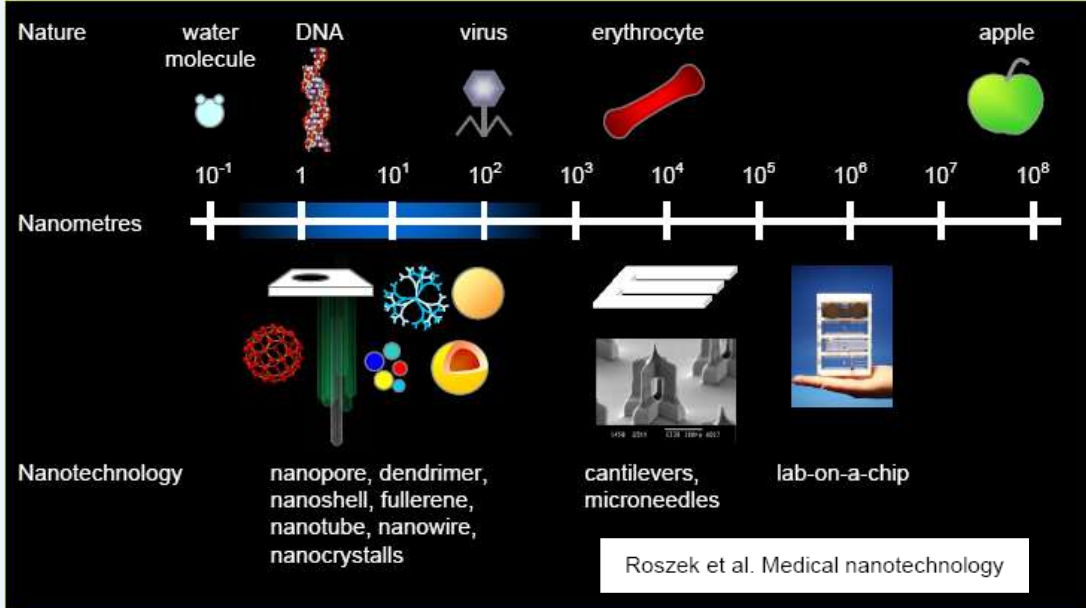
Nanoshell
A spherical hollow shell made of an insulating material, such as silica (diameter 120 nm), surrounded by a thin conducting shell, typically a few nanometers thick, made of a material like gold
Altering Nanoshell Properties + example
By varying the thickness of the conducting shell, the electric and optical properties of nanoshells can be precisely adjusted
fx.: optimizing absorption of specific frequencies, like infra-red
Gold Nanoshell on Silica Core (2)
Gold layer grows on silica core
Biocompatible gold suitable for medical applications
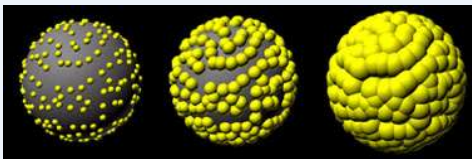
Nanoshells functions (3)
Photothermal Tumor Ablation
Delivering Insulin in Diabetes
Single Molecule Raman Spectroscopy
Photothermal Tumor Ablation (5)
Nanoshells coated with receptor molecules bind to cancer cell receptors
Nanoshells are injected into the bloodstream
High-frequency infrared light (near IR) is shone through the skin
Nanoshells absorb IR and convert it to heat, raising the tumor cells' temperature by 10-20°C
The heat causes cancer cells to die
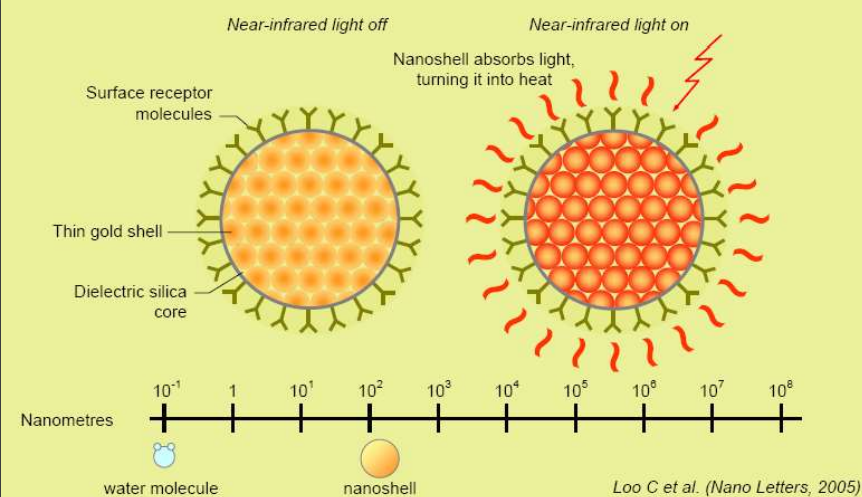
Photothermal Tumor Ablation Advantages (2)
No toxic effects (unlike chemotherapy)
No carcinogenic ionizing radiation (unlike radiotherapy or nuclear medicine)
Delivering Insulin in Diabetes (6)
In diabetes mellitus (DM), too much glucose is in the blood and not enough in the cells
Insulin moves glucose from the bloodstream into cells (muscle, fat, liver) for energy or storage
Type 1 DM (low insulin production, requires daily injections) and Type 2 DM (insulin resistance)
Porous nanoshells filled with insulin are placed on a "patch" below the skin
A pen-sized IR laser is used over the skin to release insulin from the patch
The patch may contain glucose sensors to release insulin when excess glucose is detected in the blood
Single Molecule Raman Spectroscopy (3)
Raman spectroscopy uses scattered IR photons to determine molecular structure
Nanoshells can increase the Raman signal by 1011 times
The system becomes sensitive enough to detect and determine the structure of a single molecule
fx.: chemical or biological toxins, viruses
Dendrimers definition (3)
= Nanosized ‘Containers’
globular-shaped polymers made of branched repeating units emanating from a central core
must be compatible with body
Biodendrimers
Dendrimers that are biocompatible or biodegradable
Cavities within Dendrimers definition
Serve as binding sites for smaller molecules, allowing dendrimers to act as nanosized 'containers' or 'multifunctional platforms' for various functional molecules
Function of Dendrimers (4)
Dendrimers have cavities (empty pockets or holes) formed by their branched structure
These cavities can bind various molecules
fx.: those targeting cancer cells and others that detect if the cancer cells are dead
The dendrimer's branched structure allows it to hold and release multiple functional molecules, making it useful for targeted drug delivery, diagnostics, and therapy
(photo - singular mol.)
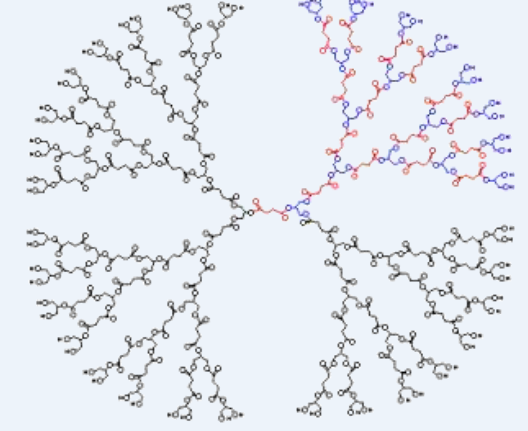
Dendrimer Multifunctional ‘Platforms’ (photo!)
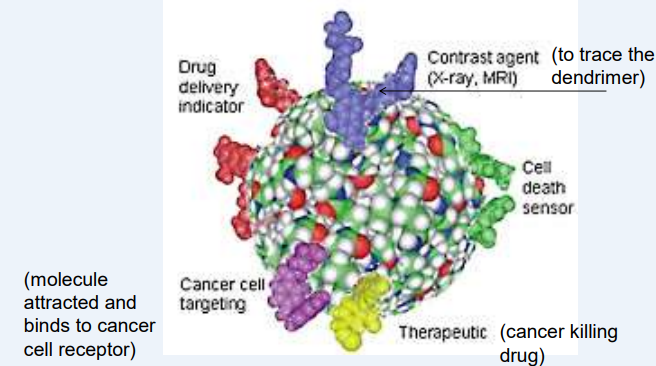
Fullerenes (3)
Nanosized carbon structures in the shape of a hollow sphere, ellipsoid, tube, or ring
Carbon is biocompatible, making fullerenes suitable for medical use
If a substance is toxic to the body, it can be inserted into the carbon structure of fullerenes - preventing direct exposure and allowing targeted application + controlled delivery
fx.: gadolinium for MRI
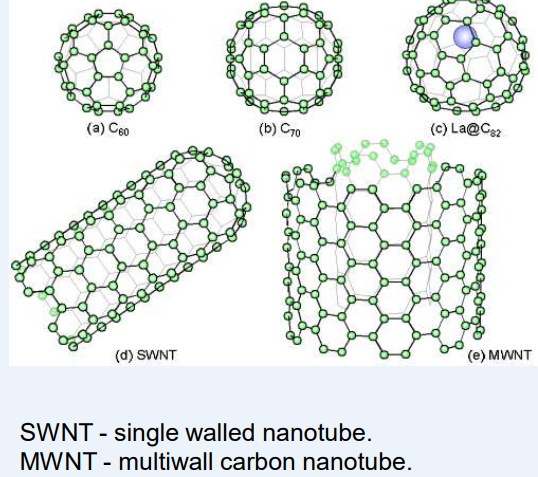
Nanotubes
Cylindrical fullerenes
Fullerenes Medical Uses (3)
Fullerenes can be used as multifunctional platforms
Nanotube Cold-Cathode X-ray Tubes
Fullerenes with Gd in MRI
Nanotube Catheters (4)
Very strong catheters
bc/ they are perfect crystals, thus hard to break
Nanotube catheters have a Young’s modulus 5 times that of steel
Lead to damages
Nanotube Cold-Cathode X-ray Tubes (3)
Small nanotube cold-cathode based X-ray tubes can be placed inside the body
Can replace radioactive sources used in brachytherapy
Major advantage: can be switched on and off
Fullerenes with Gd in MRI (4)
Fullerenes with Gd are 5 times more detectable as MRI contrast agents than current Gd agents
Fullerene helps reduce the amount of injected Gd
Gd is toxic, but fullerene helps reduce toxicity by encapsulating Gd
Can kill neurons in brain
Nanopores (2)
Nanopores drilled by a focused-ion beam in a 10 nm thick silicon nitride membrane
Scale bar is 60 nm
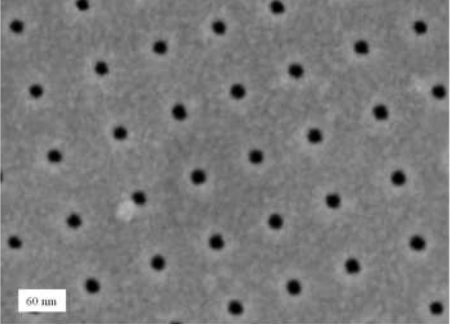
Nanopores in DNA Analysis (4)
in DNA sequencing
DNA passes through the nanopore
Different DNA bases cause different drops in current, allowing identification
Could revolutionize genomics, enabling sequencing in seconds
Nanopores in DNA Analysis Diagram (3+photo)
drops means that there is a block in channel
in ionic solution
the tube is a nanopore
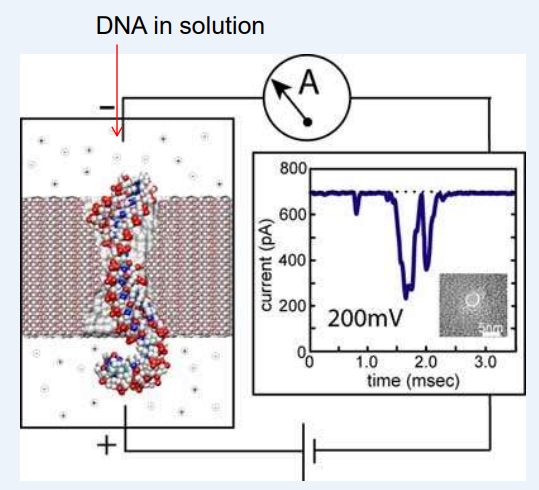
Nanocrystals (3)
= Nanoparticles
Crystalline particle with at least one dimension less than 100 nm
dif. crystal show dif. colour
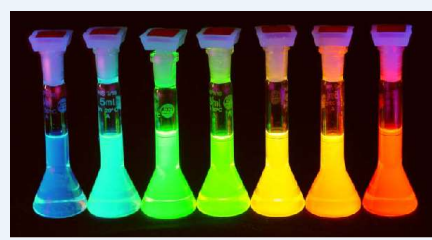
Quantum Dots (3)
Semiconductor nanocrystals in the sub-10nm size range
Have discrete energy levels (unlike larger solids)
Used as single-frequency fluorescent biological labels instead of radioactive tracers
Magnetic Nanocrystals (2)
Used as contrast agents in MRI
Example: Superparamagnetic iron oxide (SPIO)
Fluorescence Imaging (4+5)
Original Photo of Biomolecule
Initial image with possible autofluorescence from natural biomolecules
Injection with Nanocrystals
Nanocrystals are injected to enhance imaging and bind to specific biomolecules
Autofluorescence
Natural fluorescence emitted by biomolecules, which may interfere with labeled signals
Quantum Dots
Fluorescent nanocrystals used as labels for biomolecules
emitting distinct fluorescence signals
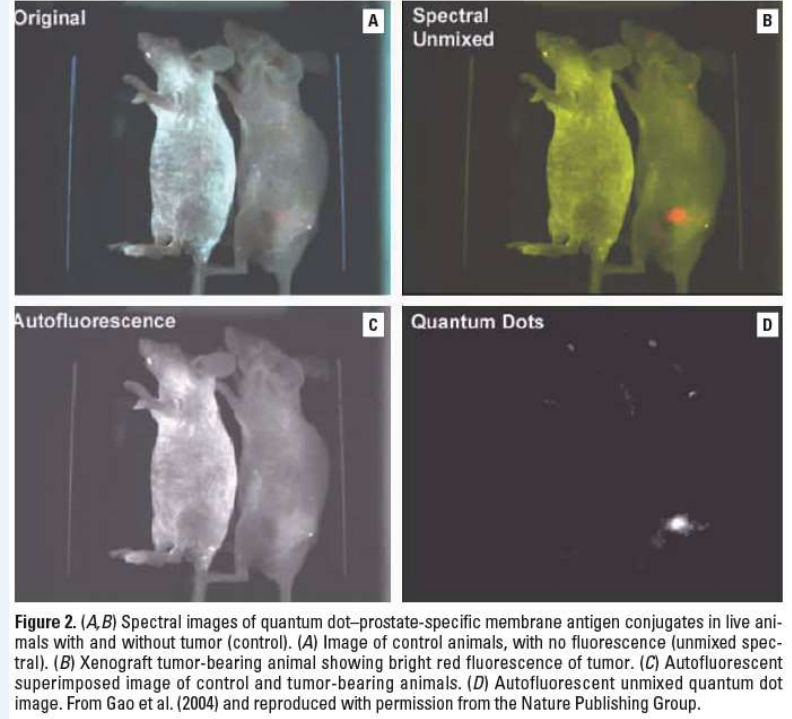
Nanowires (3)
Wires with a diameter in the order of nm
Flexible and can be as slender as 50 nanometers in width
About one-thousandth the width of a human hair
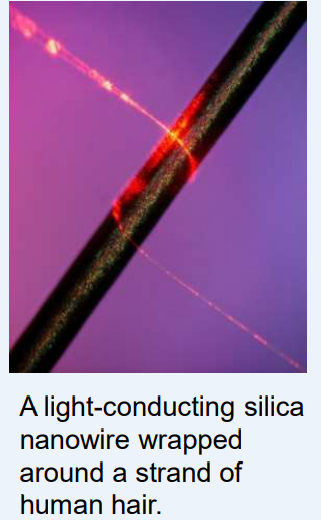
Nanowires in the Circulatory System (4)
Smaller than the smallest capillary in the body
Could be threaded through the circulatory system without blocking blood flow
Do not interfere with gas or nutrient exchange through blood-vessel walls
Too small to cause damage
Nanowires in Brain Studies and Therapy (5)
Nanowires can be guided through the circulatory system to the brain
They spread out, branching into smaller blood vessels
Used to record electrical activity of single neurons or small groups of neurons
More precise than PET or fMRI, helping to pinpoint damage from injury, stroke, or locate the cause of seizures
Too small to cause damage
Nanowires in Parkinson's Disease Treatment (3)
Nanowires can be used to stimulate affected brain areas with electrical pulses
Current stimulation involves inserting wires through the skull, causing brain tissue scarring
Nanowires threaded through blood vessels could provide the same benefits without the damaging side effects
Nanowires: Microfluidic Channels: Lab-on-a-Chip (photo)
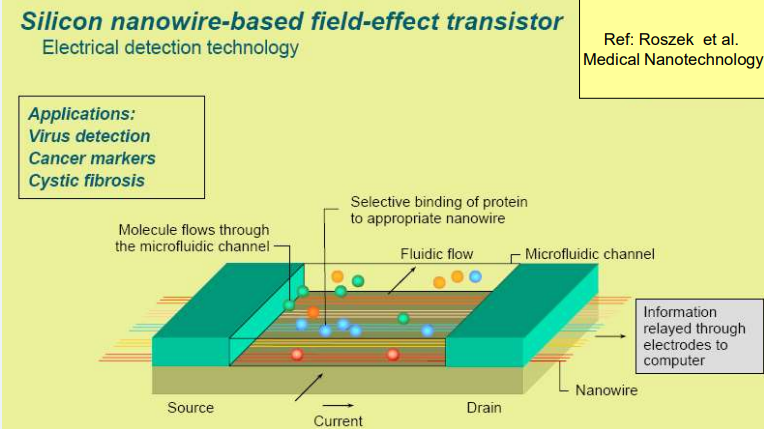
Medical Nanorobots (2)
Significant research underway
Expected to irreversibly change medicine in 20-30 years
Drug Delivery Robots
A type of medical nanorobot focused on delivering drugs precisely to targeted areas
Medical Micro-Nanorobots
used in precision medicine for highly targeted treatments
Cell Repair Nanorobots (2)
Nanorobots designed to repair or replace damaged cells
Can potentially target specific cells or tissues to restore normal function
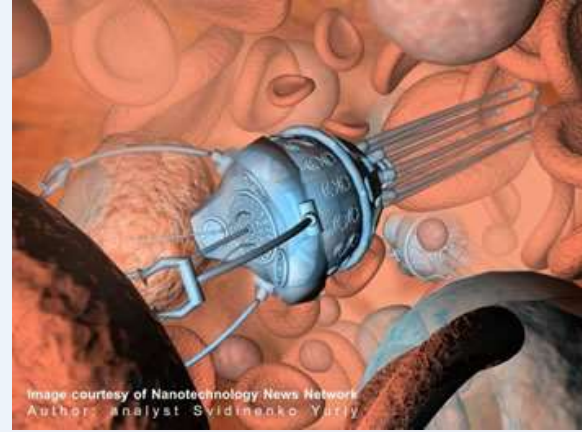
Artificial RBC ('Respirocyte') (7)
Size: 1000 nm
Can transport 236 times more O2 than natural RBCs
Use serum glucose for energy supply
Equipped with chemical, thermal, and pressure sensors, and an onboard nanocomputer
Can be remotely reprogrammed via external acoustic signals
Capable of operating indefinitely (compared to natural RBCs' 4-month lifespan)
With respirocytes, an adult human could hold their breath underwater for four hours
Consumer Products with Nanoparticles (2)
Nanoparticles are used in hundreds of consumer products
Examples: cosmetics, sunscreens, sporting goods, clothing, electronics, baby products, and food packaging
Health Risks of Nanoparticles (5)
Nanoparticles can cross biological membranes and reach cells, tissues, and organs that larger particles cannot
Can enter the bloodstream through inhalation, ingestion, or skin penetration
Once in the bloodstream, they are transported around the body and can be taken up by organs and tissues
May enter cell mitochondria and the cell nucleus
Potential risks include DNA mutation, mitochondrial damage, and cell death